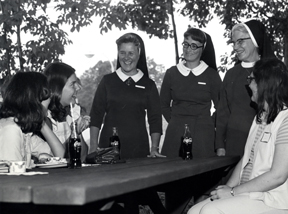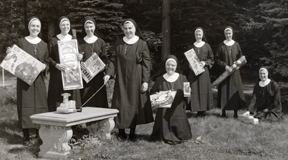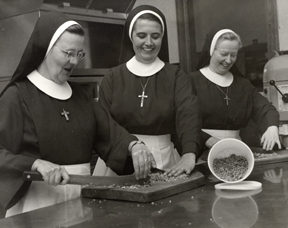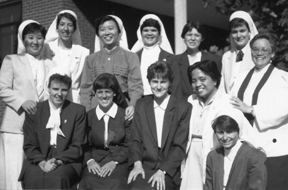Habit Experimentation

Published by: RoseDog Books
As seen above in the introduction of regional government, Mother Beata did not wait for a General Chapter to keep the Congregation moving with the Church and the winds of change coming from Vatican II. So it was also with proposing changes in the habit worn by the IHM Sisters.
The question of change in some parts of the habit, namely, the bonnet, cape, or sleeves had been proposed in the General Chapter of 1961 during Mother Kathleen Hart's time. On June 27, 1961, the chapter delegates decided to conduct a referendum across the Congregation to determine the sisters' opinions regarding change in the habit. (46)
In the Chapter of 1962, at the beginning of Mother Beata's term of office as superior general, the results of the referendum were presented. In spite of the fact that 58% of the sisters opposed any change of the habit, it was nevertheless clear that Mother Beata would soon need to address this matter in which nearly one-half of the Congregation desired some change. (47)
Support for some change in the habit was building as sisters became more imbued with Vatican IIs call for adaptation and modernization of dress. Seeing changes among the many other Congregations was also a strong influence for change.
Early in 1966, Mother Beata appointed a committee of ten sisters to conduct further study of the possible modification of the habit. The following sisters were members: Sisters John Francis Marley, Alma Marie Morgan, Lucetta Butler, Timothy Smyth, Liguori Farnon, Rose Angela Ruddy, Amata Jordan, Marie Rooney, Marysia Reilly, and Cor Immaculatum Heffernon. A detailed questionnaire was developed and sent out to the entire Congregation. Of the l196 questionnaires sent out, a response of 1,120 was received.
At the January 29, 1966, meeting, these responses were tabulated, showing more than a two-thirds majority, 1,055 sisters in favor of change. The majority of these indicated "moderate" change, a desire to retain the scapular, some modification of the bonnet, and change from the cape to a collar.
The next step was to seek models of habits, head dresses and coats which incorporated the sisters' suggestions for "moderate" change. The habit committee set a deadline of March 19, 1966, for these suggestions to be sent to Marywood. (48)
The minutes of the general council for July 21, 1966, record that action for change would not await the next General Chapter in 1968. "The modification of our own habit until final decision is made was discussed at length. All members agreed that some change should be made this year (author's emphasis) in order to test appropriate dress." (49)
"This year" turned out to be somewhere between August 15, 1966, and December 8, 1966! The letter sent to the Congregation by the habit committee, with Mother Beata's approval on August 15, 1966, informed the sisters that the "year of experimentation" had begun, that modifications were to be made to the present habit and head dress in accord with the specifications and drawings included in the letter. The statement read: "This habit and headdress may be worn as soon as each local community has completed the necessary alterations. All modifications should be finished by December 8, 1966." (50)
 |
For most local communities the changes were made during the two or three weeks remaining before school opened in September. Seamstresses were in great demand, and ripping, cutting, sewing and pressing were the major activity of the day and night.
The annals of the local communities reveal the experience of the sisters as they returned to school and other assignments in September 1966. For example:
School opened on September 7, and we made our first public appearance in our "new" habits. The children were surprisingly nonchalant at the strange sight that greeted them. (51) When had so much been accomplished in so short a time! Were we to wear our "new" habits on September first? Yes! . . . But feeling very much like new novices the day after Reception, we wore our renovated habits to the Diocesan Institute on September first. Almost everyone was happy that we, too, were heeding the advice of the Council Fathers. Of course, most glances centered around the hairline. (52)
September 8th, Our Lady's Feast Day, found us donning the new habit for the first time. At first we missed our beautiful old ones but gradually we began to feel very much at home in our "new look." Its practicality came forward when we saw the smaller wash each sister had to do, as well as the few minutes it took to iron. The people here accepted it without question . . . in fact, we had a sneaking suspicion they really liked it . . .Truly we were loved and wanted by all . . . in our old habit or new. (53)
Similar experiences were had everywhere, as blushing boys in classrooms wouldn't raise their eyes to look at sister, who, to their astonishment, had shapely legs showing beneath the shortened dress and a visible hairline.
One sister, returning to graduate school as a student just after the changes in the habit was questioned by her professor as to whether she was "wearing new glasses, or something." (54)
Being women, as well as religious, the sisters were naturally self-conscious and many longed for the more settled past or for the period of experimentation to end. As is now realized, this was not to happen.

By January 1967 the habit committee was again in touch with the sisters, informing them that tailor-made samples of habits would be displayed during the summer retreats. "At this time you will cast a final vote." (55) This was not to happen either. Throughout the year 1967 position papers were sent in to the habit committee from sisters, some calling for retaining religious dress, and others citing the need for further experimentation with various styles and materials.
At the General Chapter 1968 there was no special report from the habit committee, nor was there any great desire on the delegates' part to give much time to this matter in light of the enormous tasks of renewal of the Constitutions, government, formation and apostolate before them. By initiating experimentation in 1966 Mother Beata had effectively diverted major concern from the habit issue. The chapter delegates, on July 19, 1968, heard proposals on the habit as presented by Sister Eva Connors, discussed them, and then voted 45 to 1 to entrust further habit experimentation to the Central Administrative Assembly. (56)
The CAA issued guidelines for habit experimentation on December 5, 1968. These guidelines broadened the options to include various patterns, with or without the scapular, a jacket, if desired, and religious symbols meaningful to the individual sister. (57)
The sisters continued to wear the veil and variations of the basic habit, or blue suits and blouses until the Chapter of 1986 decided on complete option of dress.

References:
46. Minutes of the General Chapter, 1961
47. Minutes of the General Chapter, March 23-25, 1962
48. Sisters John Francis Marley and Amata Jordan. Letter to Congregation, January 29, 1966
49. Minutes of the General Council, July 21, 1966
50. Sisters John Francis Marley and Amata Jordan. Letter to Congregation, August 15, 1966
51. Annals of Epiphany Convent, Sayre, Pennsylvania. 1966-1967
52. Annals of Little Flower Convent, Washington D.C. 1966-1967
53. Annals of St. Paul Convent, New Bern. North Carolina. 1966-1967
54. Conversation with Sister Espiritu Dempsey, IHM. September 1966
55. Sister Amata Jordan, IHM. Letter to the Congregation. January 21, 1967
56. Minutes of the General Chapter of Affairs. July 19, 1968, p.2
57. Central Administrative Assembly. Letter to Congregation. December 5, 1968